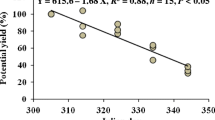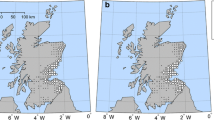Abstract
Using a weather-based model, the G2 Blackspot Manager, the impact of climate change was studied in relation to a major disease of field pea, ascochyta blight, in three different field pea growing locations of Western Australia: Esperance, Lake Grace and Merredin representing high, medium and low rainfall zones. The model was run with weather data for two 30-year periods: the period centering on 1990 (termed as “current climate”) and another centering on 2050 (termed as “future climate”). The model outputs were summarised as the epidemic-initiating ascospore-load that crops would be exposed to, disease severity, and yield loss in relation to nine times of sowing within the current sowing-window of field pea crops in Western Australia. Results show a decreased pressure of ascospore-load across the sowing-window in all three locations because of changed summer conditions (more rainy days in conjunction with higher temperatures) under future climate, which could be translated as lower disease severity compared to the current climate. The relationship between disease severity and time of sowing showed a significant decrease (P ≤ 0.05) in the intercept of the regression lines for future climate compared to current climate in all three locations, but there was no significant difference between the slopes of the regression lines. This indicated a decreased initial disease pressure for future climate compared to the current. When the impact was assessed in terms of yield loss, results in Lake Grace, in contrast to Esperance and Merredin, showed insignificant difference between current and future climates. This was a consequence of the projected dry-finishing conditions of cropping seasons, the number of which could increase two-fold in the projected future climate. It is concluded that any decrease in ascochyta blight severity as a result of climate change would most likely be location-specific.







Similar content being viewed by others
References
ABARE (2010) Australian crop report. (Australian Bureau of Agricultural and Resource Economics, No. 153, February 2010).
Bates BS, Charles SP, Hughes JP (1998) Stochastic downscaling of numerical climate model simulations. Environ Modell Softw 13:325–331
Bates BC, Pandora H, Ryan B, Smith I, Charles S (2008) Key findings from the Indian Ocean Climate Initiative and their impact on policy development in Australia. Climate Change 89:339–354
Bari MA, Berti MA, Charles S, Hasuck E, Pearcey M (2005) Modelling of streamflow reduction due to climate change in Western Australia - A case study. In ‘MODSIM 2005 International Congress on Modelling and Simulation’. Modelling and Simulation Society of Australia and New Zealand, Melbourne, pp 482–488
Berti ML, Bari MA, Clarles SP, Hauck EL (2004) Climate change, catchment runoff and risks to water supply in the South-West of Werstern Australia. Department of Environment, Perth, p 117
Bretag TW (1991) Epidemiology and control of ascochyta blight of field peas. PhD Thesis, La Trobe University, Australia.
Bretag TW, Keane PJ, Price TV (1995) Effect of ascochyta blight on grain yield of field peas (Pisum sativum L.) grown in southern Australia. Aust J Exp Agric 35:531–536
Bretag TW, Keane PJ, Price TV (2000) Effect of sowing date on the severity of ascochyta blight in field peas (Pisum sativum L.) grown in Wimmera region of Victoria. Aust J Exp Agric 40:1113–1119
Bretag TW, Keane PJ, Price TV (2006) The epidemiology and control of ascochyta blight in field peas: a review. Aust J Agric Res 57:883–902
Chakraborty S, Murray GM, Magarey PA, Yonow T, O’Brien RG, Croft BJ, Barbetti MJ, Sivasithamparam K, Old KM, Dudzinski MJ, Sutherst RW, Penrose LJ, Archer C, Emmett RW (1998) Potential impact of climate change on plant diseases of economic significance to Australia. Australas Plant Pathol 27:15–35
Charles SP, Bates BC, Hughes JP (1999a) A spatio-temporal model for downscaling precipitation occurrence and amounts. J Geophys Res 104:31657–31669
Charles SP, Bates BC, Whetton PH, Hughes JP (1999b) Validation of downscaling models for changed climate conditions: case study of southwestern Australia. Cmiulate Res 12:1–14
Charles SP, Bari MA, Kitsios A, Bates BC (2007) Effect of GCM bias on downscaled precipitation and runoff projections for Serpentine catchment, Western Australia. Int J Climatol 27:1673–1690
Coakley SM, Scherm H, Chakraborty S (1999) Climate change and plant disease management. Annu Rev Phytopathol 37:399–426
Davidson JA, Hartley D, Priest M, Herdina Krysinska-Kaczmarek K, McKay A, Scott ES (2009) A new species of Phoma causes ascochyta blight symptoms of field peas (Pisum sativum) in South Australia. Mycologica 101:120–128
Garrett KA, Dendy SP, Frank EE, Rouse MN, Travers SE (2006) Climate change effects on plant disease: genomes to ecosystems. Annu Rev Phytopathol 44:489–509
Gordon HB, Rotstayn LD, McGregor JL, Dix MR, Kowalczyk EA, O’Farrell SP, Waterman LJ, Hirst AC, Wilson SG, Collier MA, Watterson IG and Elliott TI (2002) The CSIRO Mk3 Climate System Model. Technical Paper No. 60. CSIRO Atmospheric Research: Aspendale, Victoria, Australia 130 pp.
Hay LE, Clark MP (2003) Use of statistically and dynamically downscaled atmospheric model output for hydrologic simulations in three mountainous basins in the western United States. J Hydrol 282:56–75
Hughes JP, Guttorp P, Charles SP (1999) A non-homogeneous hidden Markov model for precipitation occurrence. Appl Stat 48:15–30
McMurray LS, Davidson JA, Lines MD, Leonforte AL, Salam MU (2011) Combining pathological, agronomic and breeding advances to maximise Pisum sativum yields under changing climatic conditions in south-eastern Australia. Euphytica. doi:10.1007/s10681-011-0362-9
Peever TL, Barve MT, Stone LJ, Kaiser WJ (2007) Evolutionary relationships among Ascochyta species infecting wild and cultivated hosts in legume tribes Cicereae and Vicieae. Mycologia 99:59–77
Phillips TJ, Gleckler PJ (2006) Evaluation of continental precipitation in 20th century climate simulations: the utility of multimodel statistics. Water Resour Res 42:W032002
Salam MU, Khangura RK, Diggle AJ, Barbetti MJ (2003) Blackleg Sporacle: A model for predicting onset of pseudothecia maturity and seasonal ascospore showers in relation to blackleg of canola. Phytopathology 93:1073–1081
Salam MU, MacLeod WJ, Maling T, Barbetti MJ, Prichard I, Seymour M (2011a) A meta-analysis of severity and yield loss from ascochyta blight on field pea in Western Australia. Australas Plant Pathol. doi:10.1007/s13313-011-0034-1
Salam MU, Galloway J, MacLeod WJ, Davidson JA, Seymour PI, Salam KP, Diggle AJ, Maling M (2011b) G1 Blackspot Manager model predicts the maturity and release of ascospores in relation to ascochyta blight of field pea. Australas Plant Pathol. doi:10.1007/s13313-011-0035-0
Salam MU, Galloway J, MacLeod WJ, Prichard I, Seymour M, Davidson JA, Salam KP, Galloway J, McMurray LS, Lindbeck KD, Richardson H (2011c) G2 Blackspot Manager model to guide field pea sowing for southern Australia in relation to ascochyta blight disease. Australas Plant Pathol. doi:10.1007/s13313-011-0044-z
Schoeny A, Jumel S, Rouault F, Le May C, Tivoli B (2007) Assessment of airborne primary inoculum availability and modelling of disease onset of ascochyta blight in field peas. Eur J Plant Pathol 119:87–97
Smith B, Skinner MW (2002) Adaptation options in agriculture to climate change: a typology. Mitig Adapt Strateg Glob Change 7:85–114
Acknowledgements
We thank the Grains Research and Development Corporation (GRDC) of Australia for financial assistance in this work, and Ian Foster, Project Manager of the Climate and Weather project of the Department of Agriculture and Food Western Australia (DAFWA) for supplying the weather data. The fifth author acknowledges DAFWA for financial support of his salary and research.
Author information
Authors and Affiliations
Corresponding author
Rights and permissions
About this article
Cite this article
Salam, M.U., MacLeod, W.J., Salam, K.P. et al. Impact of climate change in relation to ascochyta blight on field pea in Western Australia. Australasian Plant Pathol. 40, 397–406 (2011). https://doi.org/10.1007/s13313-011-0050-1
Received:
Accepted:
Published:
Issue Date:
DOI: https://doi.org/10.1007/s13313-011-0050-1




